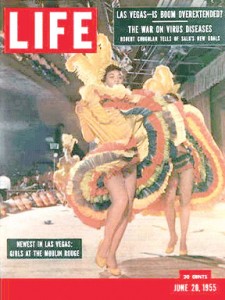
Magazine collecting opens a world of possibilities for enthusiasts of the medium.
By Kenneth Gloss
The last issue of the classic Life Magazine hit the stands in 2000 and though there is now a slimmer, less exciting version that gets inserted into some newspapers such as the Boston Herald, there are collectors who still seek that last issue of a magazine that has been around, with a couple of fits and starts and makeovers, since the 1870s. Life has always been popular among collectors and people interested in general memorabilia.
The original Life started out as a humor magazine done by Charles Dana Gibson, who was famous for his Gibson Girls artwork. Famous artists like Maxfield Parrish, Norman Rockwell and others drew the pictures that appeared in the magazine. It was nothing like what it would become when it was sold to Time, Inc. in 1934.
Time bought Life because of the name and totally reinvented it so that their new magazine presented a slice of real life to readers. The new edition, with the pictorial record of what was going on in America and the world was introduced in November of 1936.
This was an auspicious time to start a magazine like Life. World War II was just beginning and people were hungry for news from the front. Before anyone had television and before radio became the news source it is today, there was no reliable way for people to get information about events around the world. Life provided that and so much more. Pictures of the war, of social events, of entertainers, all appeared within its pages, providing a well-rounded look at the globe.
Life covered it all – from Kennedy’s assassination to Hemingway’s Old Man and the Sea, to Winston Churchill’s funeral. The magazine published only high-quality photography, accompanied by strong, excellent writing. But television brought it to its knees.
When television became widely available, people no longer needed to rely on Life to bring them news of the world. After the Kennedy assassination, the national news went from a fifteen-minute program to a half-hour, even an hour. In many ways, television rang the death knell for Life.
By 1972, Time, Inc. had abandoned the weekly issues of Life. Six years later, they resurrected it as a monthly. Although the new edition still had the same superior photographs and slice-of-life stories, the immediacy of what Life covered had been lost in the month-long wait between issues. The size was shrunk, circulation dropped and the end began all over again. When I look at Life magazine, I consider it’s ending to be in 1972 with the last of the weekly issues of that era’s issues.
 Many people still want those old issues. They aren’t very rare because Life tended to be a magazine that people held on to, unlike Newsweek or Time, which didn’t have the valued photographic impact. The most rare issue is the one that came out at the same time Kennedy was assassinated. Life originally released one with Roger Staubach on the cover, then pulled that issue and replaced it with one of Kennedy. Not all of the Staubach issues were returned and there are still a few available for collecting. One of those issues can sell for $400-$500.
Many people still want those old issues. They aren’t very rare because Life tended to be a magazine that people held on to, unlike Newsweek or Time, which didn’t have the valued photographic impact. The most rare issue is the one that came out at the same time Kennedy was assassinated. Life originally released one with Roger Staubach on the cover, then pulled that issue and replaced it with one of Kennedy. Not all of the Staubach issues were returned and there are still a few available for collecting. One of those issues can sell for $400-$500.
Most issues of Life sell for $3-$15. The popular ones are the issues featuring celebrities who have inspired collecting frenzies of their own, people such as Marilyn Monroe and Ted Williams. April 1962’s edition, which had Elizabeth Taylor and Richard Burton on the cover, is popular not for what Life put in it but for what Post Cereal did. Their ad in that issue featured a baseball card on the front with Mickey Mantle or Roger Maris, depending on which ad you saw.
Before there was Life magazine, there were other magazines that started back in the 1700s, growing in popularity with the Industrial Revolution and the advent of cheaper options for printing. The older magazines feature lithographs of Chagall and other famous artists: collector’s items that make excellent prints. One of the most beautiful magazines was Fortune, which started in 1930. The photography and writing were spectacular, in keeping with its image of being for the truly successful. Although Fortune sold for an unheard of $1.00 per issue then, many people bought it and put it on their coffee tables to give the illusion of success to visitors.
Vanity Fair, Harper’s Bazaar and Vogue all started around the same time. Many of them are collectible, also because of the artwork. They feature a number of glitzy ads that people like to extract and then hang as prints.
National Geographic is another one of those “keeper” magazines that people didn’t throw away. The very first issue, released in 1888, is the most rare, selling for up to $10,000. But as the magazine’s popularity grew, so did its numbers. An issue published after 1950 is worth virtually nothing because so many people have them.
Life Magazine’s circulation tumbled to a mere 1.5 million in 1999, signaling to advertisers that it wasn’t reaching the same audience anymore. Without those dollars from ads, the magazine couldn’t continue and ended the following year.
I miss Life. We used to display a wall full of issues that we had in the shop that often gave pause to customers. They would stand and stare at the different covers for an hour or more, wrapped in their memories of the past. Even I, who had seen these issues every day for several years would stop sometimes and marvel at the beauty of Ingrid Bergman or the photographer’s talent in capturing Audrey Hepburn. Life accomplished its goal – it encapsulated little moments of our world and brought them into the homes of nearly everyone in America. In an age of television and Internet access, however, that quality is no longer valued like it used to be.
Ken Gloss is the owner of the Brattle Book Shop in Boston, America’s oldest and one of its largest antiquarian bookstores. 2012 is the 63rd year of ownership by the Gloss family. Many recognize Ken from his appearances on PBS’ “Antiques Roadshow.” The shop is located in the Downtown Crossing section of Boston at 9 West Street. Ken’s free and open lectures, as well as other information is available on its website at: www.brattlebookshop.com or they can be reached at 800-447-9595.














Reader Comments